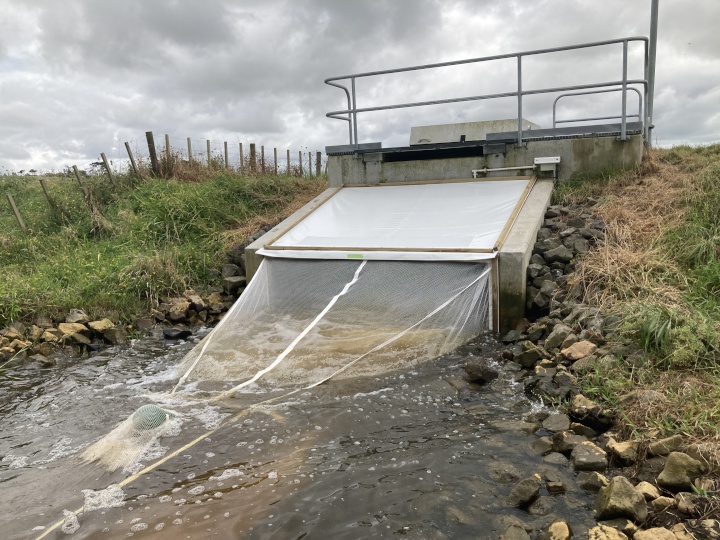New Pump Allows Tuna To Swim Another Day
Tuna (eels) in the Aka Aka catchment safely passed through the council’s new enclosed Archimedes screw pump to swim another day.

Pump: Aerial of Mangawhero pump station
A monitoring programme was held during the tuna summer migration to test the fish-friendliness of the new pump, which was designed and built by Netherlands company FishFlow Innovations and is the first of its kind in New Zealand.
Pathways to the Sea project manager Michelle White says all 206 tuna to pass through the pump during the monitoring programme did so safely, which was an extremely pleasing result.
“The council acknowledges the need for more sustainable use and management of our flood protection scheme assets, and this pump is the start of our mission to provide native fish with safe passage to the sea for spawning,” says Mrs White.
The objectives of the monitoring programme, which was developed in collaboration with Ngāti Te Ata, are:
- assess if tuna can pass through the pump safely, without injury
- determine if large tuna (over 1 metre) can safely pass through the pump
- assess if tuna avoid entering the pump.
In January this year, 162 shortfin and three longfin tuna were sourced from the Mangawhero and nearby catchments and the Te Kauwhata eel factory, tagged with passive integrated transponders (PIT tags), measured and weighed, and released upstream of the Mangawhero pump station ahead of the migration season.
A large sock net was installed at the outlet of the screw pump to capture any tuna that would pass through the pump, which started operating on 27 January due to heavy rainfall from Cyclone Hale.
A total of 206 tuna were captured in the net and assessed for injury, measured, weighed and scanned for PIT tags. They included 66 of the tagged shortfin tuna and all three tagged longfin tuna.
Senior Freshwater Ecologist Alicia Williams says the tuna, which ranged in length from 328 millimetres to 956mm, were given an injury score from 0 to 4: 0 signifies no injury or minor abrasions up to 4 meaning death or fatal wounds.
Nearly all (99.2 per cent) of the tuna scored 0, signifying no injury or minor abrasion, and two tuna scored 1 (0.8 per cent), exhibiting moderate bruising, potentially caused from passing through the pump.
“At the end of the day, 100 per cent of the tuna survived and 99 per cent of them had no or minor injuries,” says Alicia, who hopes to source and tag tuna longer than 1 metre to include in a repeat of the monitoring programme next year.
“The pump performed really well, safely passing eels over 600 millimetres in length. No eels of this size or greater tend to survive through the traditional pumps that make up much of New Zealand’s flood protection schemes.
“It’s extremely important that the large eels get through, as they tend to be the breeding females. Safeguarding these species is critical given the longfin eel is currently ‘at risk and declining’ in New Zealand.”
The PIT data will be analysed by NIWA later this year to assess whether any of the tagged tuna that didn’t go through the pump avoided doing so.
The enclosed Archimedes screw pump, which is 10 metres in length and 1.6 metres in diameter, was installed and commissioned at Mangawhero pump station near Waiuku, north Waikato, in March 2022.
In the Netherlands, trials reported very little impact on fish that pass through the pump, but New Zealand eel species tend to be larger than European eels.
The regional council has about 124 pump stations in the Waikato which help protect communities’ lives and livelihoods.
As part of its Pathways to the Sea programme, it is developing a regional infrastructure fish passage strategy that will identify and prioritise pumped catchments for fish passage and the appropriate measures to do so, such as fish-friendly pumps.
The council is also working with MacEwans Pumping Systems and Callaghan Innovation to develop a fish-friendly pump to replace existing MacEwans PPF axial pumps – found widely in New Zealand – without the need to make any civil structure modifications to pump stations. Monitoring to assess the fish friendliness of this new pump will take place in the next tuna migration season, in autumn next year.
Pathways to the Sea is a research and development project, funded by Waikato Regional Council, other councils, iwi and industry, to improve downstream fish passage at the council’s pump stations. The regional council works closely with iwi,


 Gordon Campbell: On bird flu, AUKUS entry fees and Cindy Lee
Gordon Campbell: On bird flu, AUKUS entry fees and Cindy Lee Government: Saves Access To Medicines
Government: Saves Access To Medicines Office of the Speaker: Law And Order, Finance, And Defence A Focus For Ukrainian Parliamentary Delegation To NZ
Office of the Speaker: Law And Order, Finance, And Defence A Focus For Ukrainian Parliamentary Delegation To NZ Environmental Defence Society: Fast-track Approvals Bill Presents A Serious Risk To New Zealand Exporters
Environmental Defence Society: Fast-track Approvals Bill Presents A Serious Risk To New Zealand Exporters NZ Government: New Lab To Help Protect Key Pacific Tuna Fisheries
NZ Government: New Lab To Help Protect Key Pacific Tuna Fisheries Susan Botting - Local Democracy Reporter: Ruawai Leader Slams Kaipara Council In Battle Over $400k Property
Susan Botting - Local Democracy Reporter: Ruawai Leader Slams Kaipara Council In Battle Over $400k Property Te Pati Maori: Another ‘Stolen Generation’ Enabled By Court Ruling On Waitangi Tribunal Summons
Te Pati Maori: Another ‘Stolen Generation’ Enabled By Court Ruling On Waitangi Tribunal Summons


